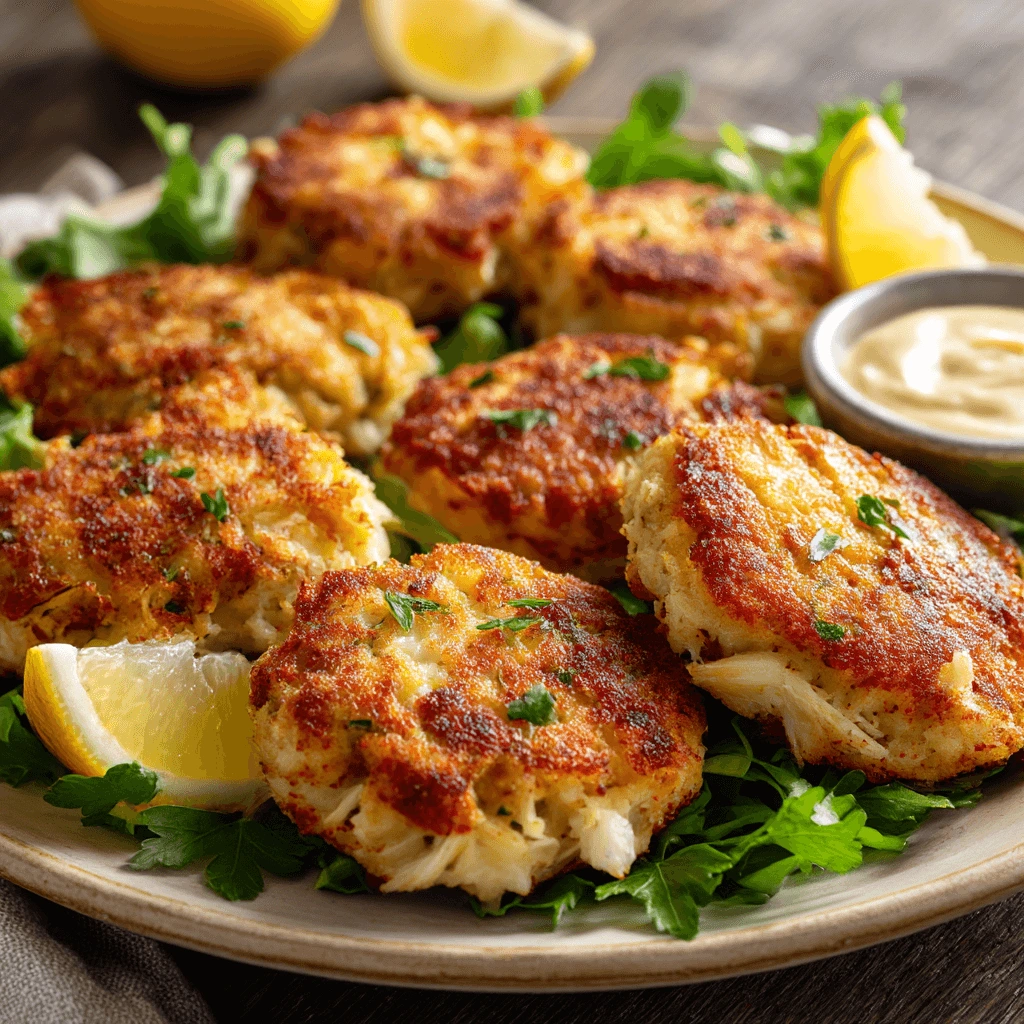
How to Make the Best Crab Cake Recipe in 5 Easy Steps
This crab cake recipe is a seafood classic—crispy outside, tender inside, and bursting with flavor. If you’ve been looking for an authentic yet easy crab cake recipe, this version is inspired by Maryland-style crab cakes that highlight sweet lump crab meat. Perfect for weeknight dinners, seafood nights, or parties, it’s a reliable crab cake recipe you’ll return to again and again.
What Makes This the Best Crab Cake Recipe
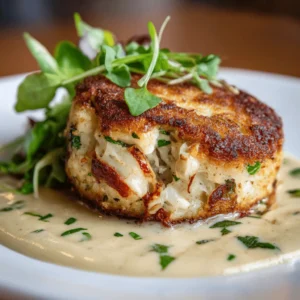
Maryland-Style vs. Other Regional Crab Cakes (Chesapeake Bay Tradition)
When it comes to the best crab cake recipe, Maryland crab cakes set the gold standard. Originating from the Chesapeake Bay region, these crab cakes are known for their simplicity and focus on high-quality lump crab meat. Instead of loading the mix with fillers like bread crumbs or heavy binders, Maryland-style recipes use just enough egg and mayonnaise to hold the cakes together. This allows the sweet, delicate flavor of the crab to shine. They’re typically pan-fried in a little butter or oil until golden and crispy on the outside, yet soft and tender inside.
Other regions take their own spin on the dish. In New England, crab cakes often include more breadcrumbs and seasoning, giving them a denser texture and bolder flavor. Down South, you’ll sometimes find crab cakes seasoned with hot sauce, bell peppers, or Creole spices for a spicy kick. On the West Coast, chefs might serve them with fresh herbs, avocado, or citrus-forward sauces to highlight local ingredients.
The key difference is balance—Maryland-style crab cakes keep it minimal and let the crab speak for itself, while other regional versions experiment with flavorings and textures. Both have their appeal, but if you want to taste the true essence of crab, a traditional Chesapeake Bay-style crab cake is hard to beat.
Using Lump Crab Meat for Authentic Flavor
The heart of any truly great crab cake recipe is the crab meat itself—and nothing compares to using fresh lump crab meat. This type of crab is prized for its large, sweet, and juicy chunks that create a tender texture and rich flavor. Unlike shredded or claw meat, lump crab holds together beautifully in patties while still giving you those big bites of crab that make every mouthful satisfying.
Maryland-style crab cakes, in particular, emphasize the importance of lump crab meat because it allows the natural sweetness of the seafood to shine. Using premium crab meat also means you don’t have to rely heavily on fillers like breadcrumbs—just a light binder of mayo and egg is enough to keep the patties together without overshadowing the crab.
If lump crab meat isn’t available, backfin crab meat is a good alternative, offering a slightly finer texture while still carrying plenty of flavor. For a budget-friendly option, you can even combine lump and claw meat to stretch your recipe while still enjoying the authentic taste.
The key is to choose the freshest crab meat possible—whether it’s freshly picked, refrigerated, or high-quality canned crab. Once you taste a crab cake loaded with real lump crab, you’ll understand why it’s the foundation of an authentic recipe.
The Perfect Blend of Seasoning (Old Bay, Worcestershire, Dijon Mustard)
While lump crab meat is the star of any great crab cake recipe, the seasoning is what elevates the flavor and ties everything together. The goal is balance—just enough spice and tang to highlight the natural sweetness of the crab without overpowering it.
Old Bay Seasoning: This iconic Chesapeake Bay spice blend is almost synonymous with crab cakes. Made with a mix of celery salt, paprika, black pepper, and other spices, Old Bay adds warmth and depth while complementing the briny, sweet flavor of crab. A little goes a long way, so you only need a teaspoon or two.
Worcestershire Sauce: Just a splash of Worcestershire provides a savory, umami punch that enhances the richness of the crab meat. It also helps the seasonings meld together, giving the crab cakes a more complex flavor profile.
Dijon Mustard: Creamy with a subtle tang, Dijon mustard adds brightness that cuts through the richness of the crab and binding ingredients like mayonnaise. It keeps the flavor fresh and balanced while preventing the cakes from tasting too heavy.
Some recipes also add a hint of hot sauce, lemon juice, or fresh parsley for extra freshness and spice. But the classic trio of Old Bay, Worcestershire, and Dijon mustard is what gives authentic crab cakes their unforgettable taste—savory, slightly tangy, and perfectly seasoned.
No Filler Approach – Crisp Outside, Tender Inside
One of the secrets to making the best crab cake recipe is resisting the urge to load the mix with fillers. While breadcrumbs and starchy binders can stretch the recipe, they often take away from what matters most—the sweet, delicate flavor of the crab. A true Maryland-style crab cake is made with minimal filler, using just enough mayonnaise and egg to hold the patties together without masking the seafood.
This “less is more” approach creates crab cakes that are light yet hearty, with big chunks of crab meat shining through in every bite. Instead of a bread-heavy cake, you get something closer to a pure crab patty that’s naturally sweet, moist, and satisfying.
Cooking method also plays a big role in achieving the right texture. Pan-frying the cakes in a little butter or oil creates a golden, crispy crust on the outside while keeping the inside soft and tender. If you prefer baking, you can still achieve a crisp exterior by brushing the patties lightly with oil before putting them in the oven.
The result is a crab cake that doesn’t feel heavy or doughy but instead delivers the perfect balance—a crisp outside for crunch, and a tender, crab-packed inside that melts in your mouth.
Ingredients for the Best Crab Cake Recipe
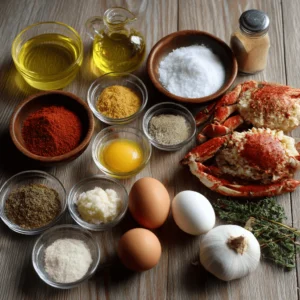
Lump Crab Meat (Fresh or Canned)
Every great crab cake recipe starts with lump crab meat. Fresh crab delivers the most authentic taste, but quality canned lump crab meat works well for convenience.
Fresh Lump Crab Meat: This is the top choice for Maryland-style crab cakes. Fresh lump crab offers the purest flavor and best texture, giving you those big, satisfying bites of crab in every patty. You can usually find it at seafood markets or in the refrigerated section of well-stocked grocery stores.
Canned or Pasteurized Lump Crab Meat: If fresh crab isn’t available, high-quality pasteurized crab meat is the next best thing. Found in sealed containers in the refrigerator aisle, it’s cooked and preserved to maintain freshness. When handled properly, it delivers nearly the same sweetness and tenderness as fresh crab.
Choosing the Right Grade: Crab meat comes in different grades—jumbo lump, lump, backfin, and claw. Jumbo lump and lump are ideal for crab cakes since they have larger, more visible chunks, while claw meat is darker, more flavorful, and can be mixed in to stretch the recipe.
Pro Tip: Always check for small bits of shell when working with lump crab meat. Gently pick through it with your fingers before mixing it into your recipe.
By starting with high-quality lump crab meat, you’re ensuring your crab cakes have that restaurant-worthy texture—meaty, sweet, and naturally flavorful—without needing to rely on heavy seasonings or fillers.
Binding Agents – Mayonnaise, Egg, Breadcrumbs or Panko
This crab cake recipe uses classic binders to hold the patties together while keeping them moist and tender.
Mayonnaise: Creamy and rich, mayonnaise acts as both a binder and a flavor enhancer. It adds moisture to the mixture, keeping the crab cakes from drying out during cooking. A couple of tablespoons are usually all you need.
Egg: Beaten egg is the classic binder in crab cakes. It helps glue the crab meat and seasonings together without overpowering the flavor. The key is not to use too much—one large egg is generally enough for a pound of crab meat.
Breadcrumbs: Traditional crab cake recipes often call for plain or seasoned breadcrumbs. They absorb excess moisture and provide structure, but too many can make the cakes heavy or bready. Maryland-style crab cakes use just a light dusting to hold things together.
Panko: Japanese-style panko breadcrumbs are a lighter alternative. Their airy texture helps bind the crab mixture without making it dense, and they can also be sprinkled on the outside of patties for an extra-crispy crust.
The secret is balance. Use just enough mayonnaise, egg, and breadcrumbs (or panko) to create a mixture that sticks together but still highlights the lump crab meat as the star ingredient. Done right, you’ll have crab cakes that are crispy on the outside, tender on the inside, and bursting with crab flavor.
Flavor Boosters – Dijon Mustard, Worcestershire, Lemon Juice, Parsley
A true Maryland-style crab cake recipe isn’t complete without Old Bay, tangy mustard, and Worcestershire for depth.
Dijon Mustard: Smooth and slightly tangy, Dijon brings a gentle kick that enhances the richness of the crab. It blends beautifully with mayonnaise and eggs, giving the mixture a subtle sharpness without being overpowering.
Worcestershire Sauce: Just a dash of this savory, umami-packed sauce adds layers of flavor that complement both the crab and the seasonings. It ties everything together with a complex, slightly smoky depth.
Lemon Juice: A squeeze of fresh lemon juice brightens the crab cakes, cutting through the richness and adding a refreshing citrusy lift. It also balances out the salty and savory notes of Old Bay and Worcestershire.
Fresh Parsley: Chopped parsley not only adds a pop of color but also a light, herbaceous note that rounds out the flavor profile. It keeps the crab cakes tasting fresh and vibrant rather than heavy.
The secret is moderation. Too much of any one booster can overwhelm the delicate crab, but when used in harmony, these ingredients enhance its natural sweetness. The result? A crab cake that’s zesty, savory, and perfectly balanced in every bite.
Optional Add-Ons – Hot Sauce, Green Onions, or Herbs
Customize your crab cake recipe with extra kick from hot sauce, herbs, or onions.
Hot Sauce: A few dashes of hot sauce add subtle heat and extra tang. It’s a popular Southern variation that balances the sweetness of crab with a spicy edge. Choose a milder sauce like Louisiana-style for just a touch of heat, or go bold with sriracha for a more modern twist.
Green Onions: Chopped green onions (scallions) provide a gentle onion flavor that’s less intense than raw onion but adds a fresh bite. They also add a bit of color to the mixture, making your crab cakes visually appealing as well as flavorful.
Fresh Herbs: Beyond parsley, herbs like dill, cilantro, or tarragon can add layers of aroma and complexity. Dill gives a clean, slightly grassy taste that pairs well with seafood, while cilantro introduces a bright, citrusy note. Tarragon offers a hint of licorice, making crab cakes taste more gourmet.
These optional ingredients shouldn’t overwhelm the crab—think of them as enhancers rather than main players. Used in moderation, they give your crab cakes a unique personality while keeping the focus on the star ingredient: lump crab meat.
For authentic flavor, most Maryland-style crab cakes use Old Bay Seasoning, a Chesapeake Bay classic that adds a savory, slightly spicy kick
Step-by-Step Instructions for This Crab Cake Recipe
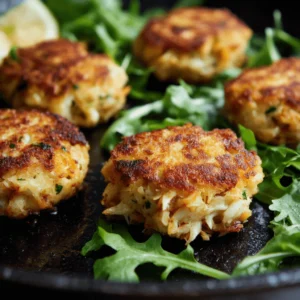
Mix Crab Meat and Seasonings for a Perfect Crab Cake Recipe
Gently fold crab meat with binders and spices. This step makes sure your crab cake recipe stays light and flaky.
Handle Crab Gently: Start by placing the lump crab meat in a large mixing bowl. Use your hands or a spatula rather than a whisk or spoon, as this helps preserve the large chunks that make crab cakes so satisfying.
Add Binders: Whisk together your binders—typically mayonnaise, egg, and a small amount of breadcrumbs or panko—in a separate bowl before folding them into the crab. This ensures the mixture coats the crab evenly without clumping.
Incorporate Seasonings: Add flavor boosters like Old Bay seasoning, Dijon mustard, Worcestershire sauce, and lemon juice. Sprinkle them evenly across the mixture to avoid concentrated spots of seasoning.
Fold, Don’t Stir: Gently fold the binders and seasonings into the crab meat. Overmixing can break apart the chunks and make the cakes dense instead of light and textured.
The goal is to achieve a mixture that holds its shape when pressed but still feels light. When mixed correctly, the crab cakes will fry or bake into patties that are crispy on the outside, tender inside, and packed with crab flavor.
Shape into Patties and Chill Before Cooking
Shaping and chilling helps this crab cake recipe hold its form when cooked.
Shaping the Patties: Scoop out portions of the mixture using a ½ cup measure or a large spoon. Gently press them into round, flat cakes about 1 to 1½ inches thick. Avoid packing them too tightly, as this can make the texture dense—lightly shaped cakes yield a more tender bite.
Consistency Check: If the patties feel too loose, add a touch more breadcrumbs or panko to absorb excess moisture. If they’re too dry, mix in a teaspoon of mayonnaise to restore balance.
Chilling Time: Place the shaped crab cakes on a parchment-lined baking sheet and refrigerate them for at least 30 minutes. Chilling allows the binders (egg and mayo) to firm up, which keeps the cakes from falling apart during cooking. For meal prep, you can chill them for several hours or even overnight.
Pro Tip: If you’re short on time, a quick 15-minute rest in the freezer works as a shortcut to firm up the patties before cooking.
Taking the time to chill the patties means your crab cakes will cook evenly, stay intact, and develop a beautiful crust while keeping the inside moist and flavorful.
Pan-Frying vs. Baking a Crab Cake Recipe – Which Is Best?
Pan-frying gives your crab cake recipe a golden, crispy crust, while baking makes a lighter, healthier version.
Pan-Frying:
Texture & Flavor: Pan-frying in a small amount of oil or butter creates that irresistible crispy crust while keeping the inside moist and tender. It’s the classic way Maryland-style crab cakes are prepared.
Cooking Time: Typically 3–5 minutes per side over medium heat until golden brown.
Best For: Smaller batches, dinner parties where presentation matters, or when you want the indulgent restaurant-style experience.
Baking:
Texture & Flavor: Baking produces crab cakes that are slightly less crispy but still flavorful and evenly cooked. It’s a healthier alternative since you use little to no oil.
Cooking Time: Bake at 375°F (190°C) for 12–15 minutes, flipping once halfway through or brushing lightly with oil for added crispness.
Best For: Larger batches, meal prepping, or when you want a lighter version that still tastes satisfying.
Some home cooks even combine both methods—bake first, then finish with a quick sear in a skillet to lock in flavor and add crispness.
In the end, both methods produce delicious crab cakes. If you want the classic Chesapeake Bay-style crunch, go with pan-frying. For a healthier, low-maintenance option, baking is your best bet.
Cooking Until Golden Brown and Crispy
The hallmark of a good crab cake recipe is a crispy exterior with a moist, tender inside.
Pan-Frying Method: Heat a skillet over medium heat with just enough oil or butter to coat the bottom. Once the pan is hot, add the crab cakes carefully. Cook for 3–5 minutes per side, resisting the urge to flip too soon. A golden crust develops when the crab cakes have time to sear undisturbed. The edges should turn crisp and slightly caramelized, while the inside stays moist.
Baking Method: Place the crab cakes on a parchment-lined baking sheet, brush them lightly with oil or melted butter, and bake at 375°F (190°C) for 12–15 minutes. Halfway through, gently flip or rotate them for even browning. While the crust won’t be as thick as pan-fried, baking still delivers a satisfying crispness.
Pro Tip for Extra Crispness: For a restaurant-style finish, sprinkle a touch of panko on the outside of the patties before cooking, or use a hot cast-iron skillet for superior browning.
The goal is consistency: crab cakes that are deeply golden on the outside yet tender and juicy inside, with chunks of lump crab meat shining through in every bite. When cooked correctly, they should be firm enough to hold their shape but soft enough to melt in your mouth.
Serving Suggestions for Your Crab Cake Recipe
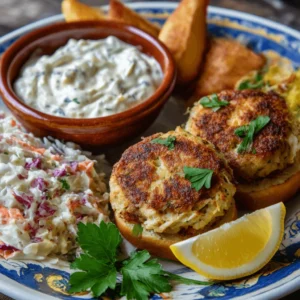
Classic Dips – Remoulade, Tartar Sauce, Aioli
This crab cake recipe pairs perfectly with tangy remoulade, creamy tartar sauce, or garlicky aioli.
Remoulade Sauce: A traditional favorite with Maryland-style crab cakes, remoulade is a creamy, slightly spicy sauce made with mayonnaise, mustard, paprika, hot sauce, and sometimes pickles or capers. Its tangy kick and subtle heat complement the sweetness of lump crab meat, making every bite more vibrant.
Tartar Sauce: Perhaps the most iconic seafood dip, tartar sauce blends mayonnaise with chopped pickles, capers, and lemon juice. Its cool, tangy flavor cuts through the richness of fried crab cakes, providing a refreshing balance that keeps each bite from feeling too heavy.
Aioli: For a more gourmet twist, aioli—a garlic-flavored mayonnaise—offers smooth creaminess with a bold garlic punch. Variations like lemon aioli or herb aioli add freshness, while roasted garlic aioli delivers depth and richness.
Each of these sauces brings something unique to the table: remoulade for spice, tartar for tang, and aioli for depth. Whether served on the side for dipping or drizzled lightly on top, these dips transform crab cakes from simple seafood patties into a restaurant-worthy dish.
Side Dish Ideas – Coleslaw, Roasted Vegetables, Fresh Salad
Round out your crab cake recipe with slaw, caramelized veggies, or a crisp salad.
Coleslaw: The cool crunch of coleslaw makes it the most classic crab cake side. The creamy dressing balances the crisp crust of the crab cakes, while the cabbage adds a refreshing bite. For a lighter option, swap out mayo-based slaw with a tangy vinegar dressing. Coleslaw also doubles as a make-ahead dish, perfect for parties or seafood feasts.
Roasted Vegetables: Warm, caramelized roasted vegetables add depth and balance to a crab cake meal. Try seasonal options like asparagus, zucchini, bell peppers, or even roasted sweet potatoes. Their natural sweetness pairs beautifully with the savory crab, while the roasting process enhances flavor without overpowering the delicate seafood.
Fresh Salad: For a lighter, summer-inspired meal, pair crab cakes with a crisp green salad. Mixed greens, cucumbers, cherry tomatoes, and a lemon vinaigrette add brightness to each bite. You can also make it a themed pairing by tossing in tropical fruits like mango or pineapple to echo the coastal, summery vibes of crab cakes.
Each of these sides works beautifully depending on the occasion: coleslaw for tradition, roasted veggies for warmth, and salad for freshness. No matter which you choose, your crab cakes will shine as the star of the plate.
Serving with Lemon Wedges and Fresh Parsley Garnish
Add brightness and freshness to your crab cake recipe with lemon and parsley.
Lemon Wedges: A squeeze of fresh lemon juice over hot crab cakes cuts through the richness of the crab and binders. The citrus adds brightness, accentuates the natural sweetness of the crab meat, and keeps the flavor profile light and refreshing. Serving wedges on the side also lets guests adjust the acidity to their taste.
Fresh Parsley: A sprinkle of finely chopped parsley (or even whole leaves for presentation) adds color contrast and a burst of freshness. Parsley’s mild, herby note doesn’t overwhelm but complements the seasoning blend—especially when Old Bay or Dijon mustard is used.
Visual Appeal: Lemon wedges and parsley also serve as edible garnishes, making your crab cakes look vibrant and inviting. It’s a small step that transforms a plate of crab cakes into a dish that looks ready for a fine dining setting.
Pro Tip: For extra flair, try lightly charring the lemon wedges before serving. Grilled lemons add a subtle smoky note that deepens the flavor profile and pairs wonderfully with pan-fried crab cakes.
With these garnishes, your crab cakes won’t just taste incredible—they’ll look and feel like a thoughtfully crafted meal, perfect for impressing family or guests.
Turning Crab Cakes into Sandwiches or Sliders
Crab cakes aren’t just delicious as a standalone dish—they can also be transformed into sandwiches or sliders for a fun and versatile way to enjoy them. This approach makes them perfect for casual meals, parties, or even game-day spreads.
Crab Cake Sandwiches: Place a golden, crispy crab cake inside a soft sandwich bun or brioche roll. Add lettuce, tomato slices, and a tangy sauce like tartar, remoulade, or lemon aioli. The bun adds a hearty element that makes the crab cakes more filling, while the toppings add freshness and balance.
Crab Cake Sliders: For a bite-sized version, use smaller crab cakes paired with mini slider buns. These are excellent for gatherings, since they’re easy to grab and eat with one hand. A dollop of coleslaw or pickled onions on top adds crunch and zest.
Creative Toppings: Go beyond the basics with gourmet touches—like avocado slices, arugula, or even a drizzle of sriracha mayo for a spicy kick. These toppings can help you tailor the sandwiches to different flavor profiles, from classic coastal to modern fusion.
Why It Works: The bread acts as a cushion, holding everything together and making the dish more portable, while the crab cakes remain the star of the show. Sandwiches and sliders are also more approachable for kids and picky eaters who may not go for plated seafood entrees.
By repurposing crab cakes this way, you give your recipe greater flexibility—it can go from a refined dinner entrée to a fun, handheld meal option with just a few adjustments.
Tips for Perfecting a Crab Cake Recipe
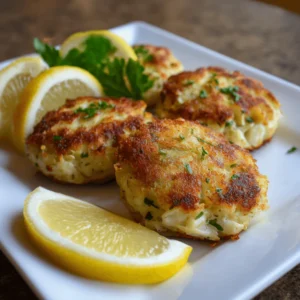
How to Keep Crab Cakes from Falling Apart
The secret to this crab cake recipe is chilling the patties and using the right binder balance.
Use the Right Binders: Ingredients like mayonnaise, egg, and a light amount of breadcrumbs or panko act as the “glue” that holds the crab together. Too little binder and the cakes crumble; too much and they become dense. A good ratio is 1 egg and ¼–½ cup breadcrumbs per pound of crab.
Chill Before Cooking: After shaping the patties, refrigerate them for at least 30 minutes. Chilling allows the binders to firm up, making the cakes easier to handle in the pan or oven. If short on time, even 15 minutes in the freezer can help.
Don’t Overmix: Gently fold the mixture instead of stirring vigorously. Overmixing breaks down the delicate lump crab meat and results in a mushy texture that falls apart during cooking.
Cook on Medium Heat: If pan-frying, avoid high heat. Medium heat ensures the outside crisps up gradually while the inside cooks evenly, preventing the patties from breaking when you flip them.
Support While Flipping: Use a wide spatula and flip carefully in one motion. For added security, you can even finish them in the oven after a quick sear to avoid excessive flipping.
By applying these simple tricks, your crab cakes will hold together beautifully while staying light, moist, and full of sweet crab flavor—just the way they should be.
Can Crab Cakes Be Made Ahead of Time or Frozen?
This crab cake recipe is freezer-friendly—perfect for meal prep or entertaining.
Make Ahead (Refrigeration):
Shaped but uncooked crab cakes can be stored in the refrigerator for up to 24 hours before cooking. This not only saves you prep time on the day of serving but also helps the patties firm up as the binders set, making them easier to cook. Simply cover the tray tightly with plastic wrap or store the cakes in an airtight container.Freezing Uncooked Crab Cakes:
Place shaped patties on a baking sheet lined with parchment paper and freeze them until solid. Once frozen, transfer them to a freezer-safe bag or airtight container, separating layers with parchment. They’ll last up to 3 months in the freezer. When ready to use, thaw in the fridge overnight before cooking as usual.Freezing Cooked Crab Cakes:
You can also freeze fully cooked crab cakes. Let them cool completely, then wrap individually in plastic wrap or foil before sealing in a freezer-safe bag. Reheat in the oven at 350°F (175°C) until warmed through and crisp.Best Practice:
For the freshest taste, freezing uncooked crab cakes is preferable, as they retain their texture better once cooked fresh. However, cooked and frozen crab cakes are still a great option for quick meals.
With these storage methods, you can always have restaurant-quality crab cakes ready in advance—perfect for parties, weeknight dinners, or last-minute entertaining.
Healthier Variations – Baked Crab Cakes, Low-Carb Options
Bake instead of fry for a lighter crab cake recipe, or swap breadcrumbs for almond flour in a keto version.
Baked Crab Cakes:
Instead of pan-frying, bake the patties in the oven at 375°F (190°C) for 12–15 minutes. Lightly brush them with olive oil or avocado oil to encourage crispness while reducing the overall fat content. Baked crab cakes still develop a golden crust but without the added calories from pan-frying in butter or oil.Low-Carb Options:
Swap breadcrumbs or panko with alternatives like almond flour, crushed pork rinds, or coconut flour to make the recipe keto-friendly and lower in carbs. These substitutes act as binders while keeping the cakes tender and moist.Healthier Binders:
Replace some or all of the mayonnaise with Greek yogurt for a lighter option that adds protein and tanginess. This substitution also reduces fat content while maintaining creaminess.Boosting Nutrients:
Add finely chopped vegetables such as bell peppers, zucchini, or spinach into the mixture for added fiber, vitamins, and texture. This not only enhances nutrition but also adds colorful appeal to your crab cakes.
By making these small adjustments, you can turn a traditional crab cake into a health-conscious version that still delivers all the flavor and texture you love. Whether you’re following a specific diet or just aiming for lighter meals, these variations prove that crab cakes can be both indulgent and healthy.
Best Occasions to Serve Crab Cakes
This crab cake recipe shines at family dinners, seafood nights, or parties.
Family Dinners:
Crab cakes make an excellent weeknight meal that feels a little special without requiring hours in the kitchen. Pair them with mashed potatoes, roasted veggies, or a fresh salad, and you have a wholesome dinner the whole family will enjoy. Kids often love them too, especially when served as sliders or with a mild dipping sauce.Parties and Celebrations:
Mini crab cakes are perfect for parties, weddings, or holiday gatherings. Served as appetizers or finger food, they’re elegant yet approachable. Add toothpicks and a side of remoulade or aioli, and you’ve got a crowd-pleaser that disappears fast.Seafood Nights:
Planning a seafood-themed dinner? Crab cakes fit right in alongside shrimp cocktails, clam chowder, or grilled fish. They bring balance to a multi-course seafood spread and highlight the sweetness of crab in a way that’s both comforting and refined.Special Occasions:
Whether it’s a romantic dinner, a festive brunch, or a summer cookout, crab cakes elevate the menu. They’re versatile enough to be plated elegantly for date night or served casually at a backyard barbecue.
Crab cakes are the kind of dish that adapts to the moment—cozy enough for family meals, festive enough for parties, and classy enough for special occasions.
Why This Crab Cake Recipe Works Every Time
With this crab cake recipe, you’ll get restaurant-quality crab cakes in your own kitchen—crispy, golden, and full of sweet crab flavor. Whether baked or pan-fried, this easy crab cake recipe guarantees success for every seafood lover. Try it once, and it will become your go-to crab cake recipe for years to come.
Crab cakes are a seafood classic—crispy on the outside, tender inside, and full of flavor. Whether you’re serving them at a family dinner or a summer gathering, this recipe brings out the best in lump crab meat. If you love comfort food, you might also enjoy our easy meatloaf recipe, another reader favorite for weeknight dinners.





